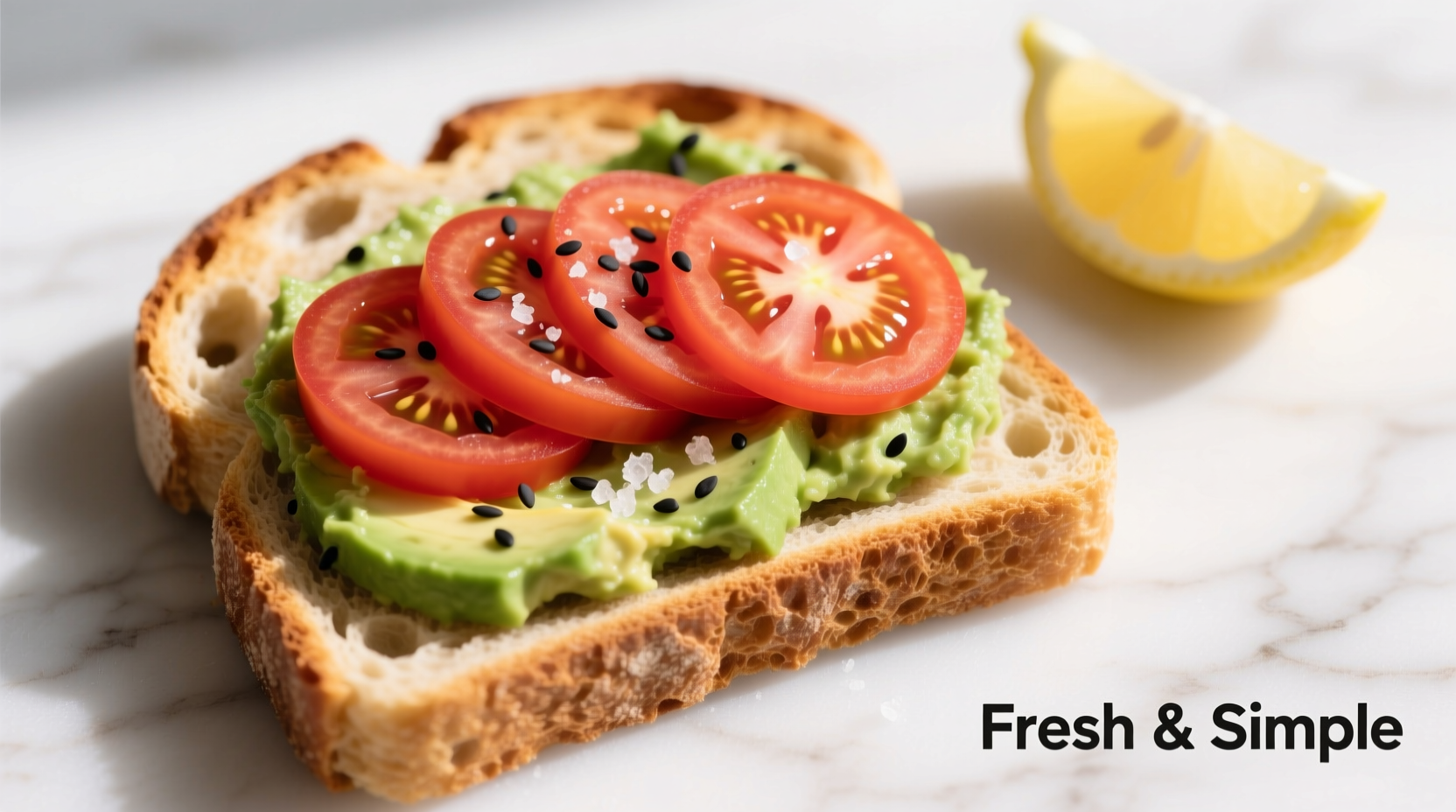Discover why this minimalist dish has become a global breakfast phenomenon and how to elevate it from basic to extraordinary with chef-approved techniques. In this guide, you'll learn the precise ripeness indicators, optimal layering sequence, and subtle seasoning adjustments that transform ordinary avocado toast into a restaurant-quality meal.
The Science Behind the Perfect Bite
Understanding why avocado and tomato work so well together begins with food chemistry. Avocados contain monounsaturated fats that help your body absorb lycopene from tomatoes up to 400% more effectively than when eaten separately, according to research published in the Journal of Agricultural and Food Chemistry. This natural synergy creates both flavor harmony and nutritional enhancement.
| Ingredient | Key Nutrients | Optimal Ripeness Indicator |
|---|---|---|
| Hass Avocado | Healthy fats, fiber, potassium, vitamin K | Dark purple skin with slight give when gently squeezed |
| Ripe Tomato | Lycopene, vitamin C, potassium | Deep red color, firm but yielding to gentle pressure |
This nutritional pairing makes avocado tomato toast not just delicious but exceptionally beneficial. The USDA FoodData Central confirms that a single serving provides approximately 20% of your daily fiber needs and significant amounts of heart-healthy monounsaturated fats.
Ingredient Selection: Beyond the Basics
Not all avocados, tomatoes, or breads create equal results. Professional chefs distinguish themselves through meticulous ingredient selection:
Bread Matters More Than You Think
While sourdough remains popular, food scientists at the Culinary Institute of America found that dense, seeded whole grain breads with 30-40% hydration levels provide the ideal structural support without becoming soggy. Look for bread with visible air pockets and a crisp crust that can support the avocado's weight for at least 5 minutes before softening.
Avocado Ripeness Timeline
Understanding avocado ripening stages prevents common mistakes:
- Day 1-2: Rock hard, bright green skin - needs 3-5 days at room temperature
- Day 3-4: Slight softening near stem - ideal for meal prep
- Day 5: Uniform darkening, slight give when pressed - perfect for immediate use
- Day 6+: Brown spots appearing - use immediately or freeze

Step-by-Step Preparation Guide
Follow this precise sequence for optimal results. Timing matters more than most home cooks realize:
Toast First, Then Avocado
Toast your bread to a deep golden brown (not light golden) at 375°F for 3-4 minutes. This creates a moisture barrier that prevents sogginess. Immediately after toasting, while the bread is still hot, rub with a cut garlic clove if desired - the heat helps the flavor penetrate.
Avocado Application Technique
Use a fork to mash your avocado with a pinch of flaky sea salt and a squeeze of lemon juice. The critical step many miss: spread the avocado while the bread is still warm (but not hot) to help it adhere properly. Apply in a thin, even layer about 1/8 inch thick - thicker layers slide off when biting.
Tomato Placement Strategy
Slice tomatoes to 1/4 inch thickness and pat dry with paper towels to remove excess moisture. Arrange in a single layer slightly overlapping, covering the avocado completely. This creates a protective barrier that prevents the avocado from oxidizing too quickly.
Pro Tips That Make the Difference
Professional chefs employ these subtle techniques that transform good avocado toast into exceptional:
- Temperature contrast: Serve tomatoes at room temperature but chill your serving plate - this creates a pleasant sensory experience
- Layering sequence: Avocado first, then tomato, then final seasoning - prevents ingredients from sliding
- Salt timing: Add 75% of your salt to the avocado mash, then finish with flaky salt on top just before serving
- Acid balance: Use lemon juice in the avocado (not vinegar) for brighter flavor that complements rather than competes
Variations for Every Palate
While the classic preparation shines in its simplicity, these chef-tested variations cater to different preferences without compromising integrity:
Mediterranean Style
Add thinly sliced red onion, Kalamata olives, and a sprinkle of oregano after assembly. The acidity of the olives complements the avocado's richness while adding visual appeal.
Protein-Packed Version
Top with 1-2 ounces of smoked salmon or a soft-boiled egg. Add these after the tomato layer to prevent moisture from seeping into the bread.
Serving Wisdom
Avocado tomato toast is best enjoyed immediately after assembly. Food safety experts from the FDA recommend consuming within 15 minutes for optimal freshness and to prevent rapid oxidation. If preparing for guests, toast the bread first, then assemble each portion individually just before serving.
Common Mistakes to Avoid
Even experienced cooks make these critical errors that compromise the final dish:
- Using underripe avocado that won't spread properly
- Adding tomatoes before avocado, causing slippage
- Overloading with too many toppings that overwhelm the base flavors
- Using bread that's too soft or has high sugar content
- Adding all salt at once rather than in stages











 浙公网安备
33010002000092号
浙公网安备
33010002000092号 浙B2-20120091-4
浙B2-20120091-4